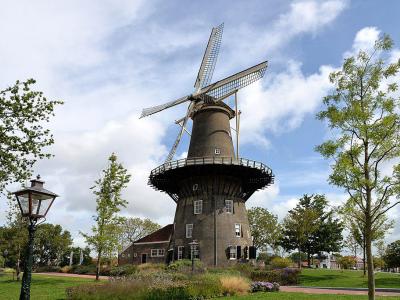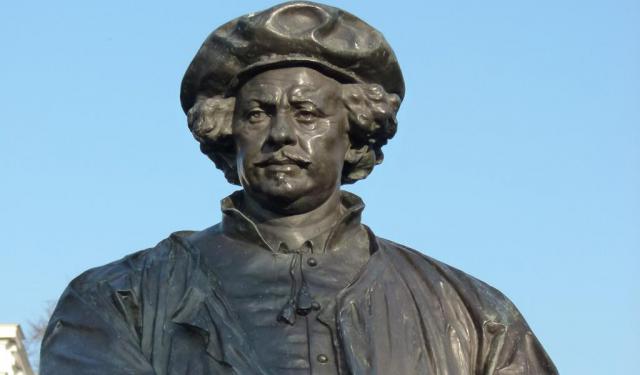
Molen de Valk (Windmill de Valk), Leiden (must see)
Nineteen mills have been built on the walls of Leiden. Only the Windmill de Valk stands today. The original mill, De Valck (the Falcon) was built in 1611 on the Valkenburger bulwark. It was replaced by a wooden tower mill in 1667. In 1743 a higher tower mill was installed. The mill had to be high above neighboring houses to catch the wind.
The ground floor of the mill and the two attached buildings held kitchens and living quarters for two families. Bedrooms were located on the first and second floors. The third floor was used for storage. The actual milling took place from the fourth floor (46 feet high) to the top of the mill (92 feet high).
The uppermost floor is called the cap loft. The cap, or roof of the mill, can be turned to catch favorable winds. A large round bearing with rollers is used. The sail axle turns in the cap. It has a nine-foot brake wheel and brake pads. The cap loft is closed to the public. The rolling wheels and gears make things a tad risky for tourists.
The hoisting loft holds the hoisting machinery that lifts sacks of grain to the top of the mill. Inside the mill is a system of hatches in a line, one above the other. The grain is hoisted through the hatches into silos. Grain is poured from the silos to the grinding stones in the stone loft. Only one pair of stones is used today.
The grinding loft is the miller's workplace. From the loft gallery, he judges the wind and turns the cap accordingly. By adjusting the sails, he can control the speed of the mill. Here is where the sacks are filled, weighed, and tested.
In the Windmill de Valk, the first, second, and third floors are exhibition rooms. The first floor holds the exhibit "The Mill, the symbol of Holland." The second floor tells the story of the Leiden Millers' guilds and the history of de Valk. The third floor features the entire history of milling and the different types of mills.
The living room is a formal family room, a parlor. The Windmill de Valk was turned into a municipal museum in 1966.
The ground floor of the mill and the two attached buildings held kitchens and living quarters for two families. Bedrooms were located on the first and second floors. The third floor was used for storage. The actual milling took place from the fourth floor (46 feet high) to the top of the mill (92 feet high).
The uppermost floor is called the cap loft. The cap, or roof of the mill, can be turned to catch favorable winds. A large round bearing with rollers is used. The sail axle turns in the cap. It has a nine-foot brake wheel and brake pads. The cap loft is closed to the public. The rolling wheels and gears make things a tad risky for tourists.
The hoisting loft holds the hoisting machinery that lifts sacks of grain to the top of the mill. Inside the mill is a system of hatches in a line, one above the other. The grain is hoisted through the hatches into silos. Grain is poured from the silos to the grinding stones in the stone loft. Only one pair of stones is used today.
The grinding loft is the miller's workplace. From the loft gallery, he judges the wind and turns the cap accordingly. By adjusting the sails, he can control the speed of the mill. Here is where the sacks are filled, weighed, and tested.
In the Windmill de Valk, the first, second, and third floors are exhibition rooms. The first floor holds the exhibit "The Mill, the symbol of Holland." The second floor tells the story of the Leiden Millers' guilds and the history of de Valk. The third floor features the entire history of milling and the different types of mills.
The living room is a formal family room, a parlor. The Windmill de Valk was turned into a municipal museum in 1966.
Want to visit this sight? Check out these Self-Guided Walking Tours in Leiden. Alternatively, you can download the mobile app "GPSmyCity: Walks in 1K+ Cities" from Apple App Store or Google Play Store. The app turns your mobile device to a personal tour guide and it works offline, so no data plan is needed when traveling abroad.
Molen de Valk (Windmill de Valk) on Map
Sight Name: Molen de Valk (Windmill de Valk)
Sight Location: Leiden, Netherlands (See walking tours in Leiden)
Sight Type: Museum/Gallery
Guide(s) Containing This Sight:
Sight Location: Leiden, Netherlands (See walking tours in Leiden)
Sight Type: Museum/Gallery
Guide(s) Containing This Sight:
Walking Tours in Leiden, Netherlands
Create Your Own Walk in Leiden
Creating your own self-guided walk in Leiden is easy and fun. Choose the city attractions that you want to see and a walk route map will be created just for you. You can even set your hotel as the start point of the walk.
Leiden Introduction Walking Tour
In the year 860, at the confluence of the Old Rhine and the New Rhine, there was a settlement called "Leithon." This word referred to a canalized river. The name is appropriate. Leiden from its beginnings was a city of canals.
In 1060 Alewin I, landlord of Leiden, built his fortified keep, the "Burcht" ("Fort"). The village of Leiden huddled around the fortified... view more
Tour Duration: 1 Hour(s)
Travel Distance: 2.2 Km or 1.4 Miles
In 1060 Alewin I, landlord of Leiden, built his fortified keep, the "Burcht" ("Fort"). The village of Leiden huddled around the fortified... view more
Tour Duration: 1 Hour(s)
Travel Distance: 2.2 Km or 1.4 Miles
In the Footsteps of Young Rembrandt
Once a thriving hub for trade and textile manufacturing, and a home to Holland's oldest university, Leiden also made history as the birthplace of Rembrandt van Rijn, one of the greatest visual artists of the mankind, renowned for his ingenious use of light and shadow, and life-like portraits. The Golden Age of the Netherlands can still be felt in Leiden, especially if you follow in the... view more
Tour Duration: 1 Hour(s)
Travel Distance: 1.2 Km or 0.7 Miles
Tour Duration: 1 Hour(s)
Travel Distance: 1.2 Km or 0.7 Miles


